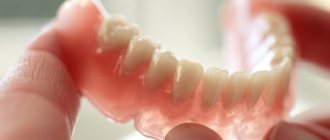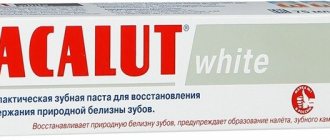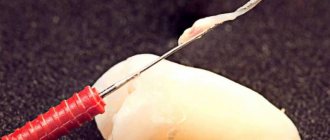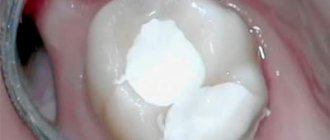Gold crowns on teeth have not lost their popularity (although it is, of course, not the same as before) even with the advent of new technologies in the field of prosthetics. Metal dental crowns remain the strongest, most durable, most ductile, and gold is still considered one of the best metals. Currently, orthopedists install ceramic structures, which wear out much faster than gold prostheses.
Gold crowns can now only be ordered from government dental clinics that are licensed to work with precious metals. It is quite difficult to obtain such permission. For this reason, dentists usually use alloys that also contain gold. Unlike past times, they now prefer to install gold crowns not on the front, but on the side teeth - incisors and molars, which are not very visible when smiling.
Features of gold crowns: what they are, how to install and remove them
Article navigation
- Use of gold in dentistry
- Features of pure gold prostheses
- Types of gold dental crowns
- Advantages and disadvantages of prostheses
- Indications for installation of crowns made of precious metals
- Who should not get gold prostheses?
- Features of making prostheses
- How does the installation work?
- Adjustment period: main problems
- How to remove a gold crown
- Who gets the crown after removal?
- Is it possible to clean the crown from glue residues?
- Features of product care
- How long can the product be used?
Question for a specialist
Until recently, a smile with a golden sheen was considered an indicator of the owner’s presentability and wealth. Gold crowns, due to the safety and softness of the material, were extremely popular, and the durability of the products is still demonstrated by representatives of the older generation. Meanwhile, modern materials used in dental prosthetics better meet aesthetic requirements. Why do many people prefer gold, what are the features of such products, how to clean gold crowns from residues - more on this and much more later in the article.
When should it be removed and how should it be separated?
In a number of situations, the crown needs to be removed and there are reasonable indications for this. It is necessary to remove a dental structure if:
- Nerve removal. When installing a gold crown, the tooth pulp is removed. But sometimes this procedure is ignored and this can lead to inflammation and acute pain. The causes of pulpitis under the crown may be recurrent caries that has not been properly treated, or trauma. In such situations, it is necessary to urgently seek professional help.
- Inflammatory diseases in the oral cavity near the crown.
- In some cases, food debris can accumulate at the border of the crown and tooth, which leads to the formation of stone and inflammatory processes of tissue in the area of the prosthesis. To carry out sanitation, it may also be necessary to remove the microprosthesis.
- Deformation of the bite, for example due to injury or due to the absence of some teeth.
- End of the crown's shelf life. Typically this period is about 20 years.
- Desire to replace the crown with another material.
- Damage to cement.
The orthopedic structure must be removed only in professional institutions using specialized instruments and preparations.
Crowns are removed in various ways:
- The drill was previously used everywhere, but in modern dentistry this method is used quite rarely. After cutting, the crown is destroyed and cannot be reused. In most cases, the structure is no longer used for microprosthetics and the remaining gold is used for other purposes.
- Removal using ultrasound is a more gentle method for both the material itself and the patient’s organic tissues. In this case, the structure is not deformed during its elimination. The disadvantage of the procedure is that the effects of the waves are very gentle and one procedure may not lead to the desired effect. In this case, removal occurs in several stages, over several steps.
- The manual crown remover is used as a cement-breaking mechanism and allows the specialist to pick up the base of the prosthesis and gradually remove the structure.
- Another tool is the Kop apparatus , which is a hook that operates automatically, producing successive shock waves. The destroyed fastenings weaken and the crown is removed using special forceps.
- The Coronaflex device works with compressed air, which destroys the cement fixation with a directed jet.
Each method has its own advantages and disadvantages.
You cannot remove the crown yourself. This option is permissible only in the case of spontaneous loosening and detachment of the prosthesis.
Features of pure gold prostheses
Pure metal is not used to make gold “caps” - due to its high softness, it is not suitable for replacing natural teeth. As a rule, they use 900 and 750 gold, combining it with other elements (silver, copper, platinum), achieving the desired properties. By adding cadmium and brass, a 750 alloy is obtained, which is used as a solder to join individual parts of the prosthesis.
South Korean implant Osstem - from 35,000 rubles.
Hurry up to sign up for a free consultation and lock in promotional prices.
Call now or request a call
Opening hours: 24 hours a day - seven days a week
Apart from the aesthetic side of the issue, gold is an ideal material for dental reconstruction. It is not susceptible to rust, does not react with other metals, and does not cause allergies. Exceptional strength is combined with softness: the product tightly covers the patient’s own tissues, leaving no gaps for infection.
Another feature of gold crowns that allows their use in dentistry is the rate of compression and expansion of the precious metal, which is identical to that of one’s own dental tissues. This makes it possible to avoid the appearance of cracks and metal separation from the base during operation of the product.
Moreover, gold dentures are resistant to natural and artificial dyes, do not darken, and maintain a smooth structure for a long time.
What alloys are they made of?
The list of materials that are suitable for the manufacture of such structures includes:
- alloy of chromium and cobalt
- chromium-nickel alloy
- high titanium alloys
- alloys containing precious metals (precious alloys)
Interesting fact! Titanium is resistant to aggressive factors, does not darken and does not provoke the development of allergic reactions, therefore it is often included in alloys for the manufacture of cast dentures. And alloys containing gold in their composition are characterized by ductility, which ensures an accurate fit to the gum.
Solid crowns are also divided into the following types:
- metal coated
- metal without coating
- metal with ceramic lining
- combined bridges
Designs without coating are usually made of polished metal, are low in cost, but are often not suitable for patients due to their unaesthetic appearance. Metal structures coated with gold look more attractive. However, spraying can negatively affect the mucous lining of the oral cavity.
Solid crowns with veneer are covered with ceramic material and look the most aesthetically pleasing. For longevity, recommended care instructions must be followed. A combined prosthesis is made from several metal-ceramic prostheses (which cover the smile area) and from solid crowns.
Types of gold dental crowns
There are two types of gold crowns for teeth:
- stamped - considered an outdated method of prosthetics made from industrial blanks (sleeves) or plates. They have a lot of disadvantages: lack of aesthetics, risk of gum injury, loose fit, the need to use a large amount of cement, in which gaps form over time,
- solid cast - a more modern method, which is based on the use of special equipment. They make it possible to exactly replicate the contour of a natural tooth, do not cause harm to soft tissues, and are characterized by a long service life. Among the disadvantages is the need to grind down a large amount of the tooth before installation.
In addition, gold products can be partially or completely covered with ceramics (metal-ceramic products), but they belong to a different type of prosthetics.
What type of denture can be used for the upper jaw?
Crowns
This non-removable type is used when the tooth is destroyed, but the root part is healthy (otherwise it is installed on an implant). The main tasks of the crown are to protect against further destruction and restore function. In modern dentistry, the following options are most often used:
- the most popular are metal-ceramic (metal frame with ceramic lining), metal-free or zirconium dioxide
. They have high strength and excellent aesthetics - indistinguishable from your own tooth; - cast metal crowns
are also sometimes used . They are quite durable, but visible in a smile and conversation; - stamped metal ones
are the cheapest, but short-lived and noticeable, and therefore are not used so often.
Life time
– from 3 years for stamped ones, up to 10-25 years or more for zirconium dioxide and metal-ceramic. Among the latter, frames made of titanium and an alloy of palladium and gold are particularly durable.
Dental bridge
Fixed technology to compensate for several adjacent lost teeth - from 1 to 4. Consists of two crowns, between which artificial units are located. The structure is installed on your own (supporting) teeth, and if they are missing or in poor condition, on implants. The most popular types of dental bridges are metal-ceramic, metal-free, and zirconium dioxide. They are strong enough to be used on painters and provide optimal pressure on the gums. Service life is from 10-15 years. Among the advantages of this technology:
- invisibility
– can be used even on the most visible areas of the upper jaw; - high level of restoration
of chewing functions; - comfort
for the patient - a minimum of contraindications, a short period of adaptation (from several hours to several days), after which the bridge completely ceases to be felt.
Advantages and disadvantages of prostheses
Why do they put gold crowns on teeth? Products made from this metal have many advantages over other materials:
- have high antibacterial properties,
- do not cause allergies,
- do not lead to galvanic effect,
- have a long service life,
- characterized by increased strength,
- high plasticity rates make it possible to tightly fit the prosthesis on a unit of the dentition,
- do not have a negative effect on the enamel layer of neighboring teeth,
- do not cause irritation or increase sensitivity of soft gum tissues,
- the alloy does not contain any components harmful to health,
- do not oxidize,
- can be used for prosthetics of any unit of the dentition.
At the same time, one cannot fail to note some negative aspects of using gold crowns. For example, installing such products on the front teeth cannot be called aesthetic. In addition, the cost of gold prostheses is not affordable for all patients. They are often more expensive than even zirconium dioxide.
Are gold crowns being installed now, and in what cases?
In the USSR, gold was widely used in prosthetics. And now, in certain situations and in certain clinics that have a special license to work with precious metals, precious teeth can be supplied. Here are the main indications:
- Allergic reactions to other dental materials;
- The need to restore chewing teeth on the upper and lower jaws.
Gold crowns are placed under certain conditions:
- Careful preparation, including turning the enamel;
- The absence of dental products made of other metals in the mouth, in order to avoid electrochemical reactions, damage to healthy tissue and poisoning.
There are still opportunities for interested patients - for example, to take advantage of gold crowns as a type of prosthetics and get rid of its disadvantages - to do ceramic coating and maintain aesthetics. Next is a more detailed comparison of various prostheses for patients who make a responsible choice.
Advantages and disadvantages of gold crowns compared to others
We have compiled a table showing the differences between microprostheses depending on the material:
| Character/species | Gold | Metal ceramics | Metal-free ceramics | Zirconium dioxide |
| Aesthetic indicators | Not used in the smile area due to its specific appearance | It is better not to use in the smile area | High aesthetic indicators, placed in the smile zone | Ideal aesthetics, suitable for any area |
| Human tissue compatibility | Complete, does not cause allergies | There may be allergic reactions | Complete, does not cause allergies | Complete, does not cause allergies |
| Chemical interaction with saliva and food components | No | May be | No | No |
| Protective effect for abutment teeth | Yes. The gold crown fits tightly, the metal has an antibacterial effect | A carious process may well develop under the structure. | A carious process may well develop under the structure. | A carious process may well develop under the structure. |
| Strength and resistance to stress | High | High | Average | The tallest |
| Risk to the enamel of the opposing tooth | No | Eat | Eat | Eat |
| Risks of chips and other damage | No | Eat | Eat | Minimal |
| Service life | Up to 20-25 years | Up to 7-10 years | Up to 10-15 years | Up to 10-15 years |
| Price | High | Depends on the underlying metal | High | The tallest |
As you can see, there is a lot to think about. In any case, the choice of whether to install gold crowns or prefer another material should be made after a thorough diagnosis, taking into account all individual characteristics.
Indications for installation of crowns made of precious metals
A gold crown can be placed if the following indications exist:
- violation of the anatomical shape of the tooth,
- increased abrasion of the enamel layer,
- bruxism,
- if you are allergic to other, inexpensive alloys, in particular medical steel or nickel,
- the need for additional strengthening of the dental unit,
- tooth decay (usually the chewing group).
Some patients insist on using gold when undergoing dental prosthetics, so such a product can be installed at will.
How to properly clean metal-ceramic dental crowns
The popularity of metal-ceramic crowns is deserved. They are durable, reliable and comfortable to use. The smooth surface of the products copes well with plaque. A beautiful snow-white smile that does not lose its tonal freshness over time is a huge plus.
But everything needs care, even such durable technological designs. To the delight of metal-ceramic wearers, cleaning dental crowns of this type does not cause difficulties. It differs from caring for real teeth and also requires regularity. However, there are no difficulties, and no specific manipulations are required.
Features of making prostheses
The process of making a gold crown depends on the type of product:
- stamped - based on X-ray data, a plaster blank is made in a dental laboratory, which is subsequently transferred to a gold sleeve. Using special tools and equipment, the specialist gives the precious metal product the desired shape and size, and then sends it to the clinic,
- solid cast - the orthopedic dentist takes impressions of both jaws, on the basis of which a wax model of the future product is made in the dental laboratory. Using a wax blank, the technician casts a gold crown and adjusts it to the specified parameters.
Throughout the entire manufacturing period, the patient is provided with a temporary structure.
The benefits of an irrigator when caring for crowns made of zirconium and other materials
The irrigator is ideal for caring for crowns and dental structures. The operating principle of the irrigator is based on a directed pulse of water with adjustable intensity. Such equipment massages the gums and effectively cleans the interdental space. Unlike dental floss, it is impossible to damage soft tissues with an irrigator; there is absolutely no discomfort during such treatment.
You can purchase the irrigator in a stationary or portable version. The second option is slightly inferior in terms of water capacity, but you can take the device with you and care for your oral cavity while traveling.
How does the installation work?
The installation of gold crowns can be generally described as follows:
- on a previously prepared tooth (ground to 0.5-1 mm, depulped), a prosthesis obtained from the laboratory is tried on, if necessary, it is adjusted,
- check the density of shrinkage and the correct closure of the teeth, while the patient should not feel discomfort,
- fix the product with dental cement.
You need to remember that you cannot get a gold crown in the first clinic you come across. To manufacture and install such products, a medical institution and laboratory must have a license. In addition, the specialist must have at least 5 years of work experience in this field.
Installation
The process of installing gold crusts takes several visits to the dentist’s office:
- At the first visit to the doctor’s office, the patient’s oral health is examined, caries is treated and, if necessary, old fillings are replaced. The dentist grinds the tooth on which the gold structure will be installed. In this case, dense dental tissues are ground down within 1 mm, when for metal-ceramic dentures this figure reaches 2 mm.
- After making impressions, the doctor makes a temporary overlay plastic prosthesis on site, which protects the tissues of the supporting tooth and performs an aesthetic function.
- At the second visit, the dentist tries on a wax model of the prosthesis for the patient, adjusting it and correcting any identified deficiencies.
- During the patient's third visit to the doctor, the final gold crown is tried on and fixed with temporary cement for up to three months. This is necessary in order to finally verify the correctness of manufacture and the comfort of the design.
- After 3 months, the crown is removed, cleaned of cement residues, and its effect on soft tissue is checked. If there are no contraindications, the gold prosthesis is fixed to permanent composite materials.
You can get crowns on your teeth in Moscow at a cost-effective rate at Dantistoff Scientific Dentistry. Orthopedic dentists, candidates of sciences of the highest category. Sign up.
Adjustment period: main problems
Immediately after installation, you should not drink or eat for about 2 hours (the dentist will indicate a more precise time, since the duration of the period of abstinence depends on what type of cement was used for fixation). There are no special requirements regarding lifestyle changes.
In some cases, while getting used to the structure, the patient may encounter problems such as pain and discomfort, and increased tooth sensitivity. You must inform your dentist who performed the installation about any unusual or unpleasant sensations. It may be necessary to correct the position of the crown, or the situation is temporary, and the use of special products (rinse aid, paste) will be sufficient.
It will take some time to get used to, during which it is advisable to avoid eating solid foods so as not to accidentally damage your cheek or tongue.
How to install
After making the gold crown, the specialist begins installation. You can insert gold teeth in just a few steps. The approximate procedure is as follows:
- after grinding the tooth, a temporary structure is placed to protect it from destruction and discomfort;
- fitting and correction of the finished crown in the oral cavity is performed;
- the structure is installed and fixed with special cement.
Immediately after installation, you can return to your normal rhythm of life. But to be on the safe side, it is not recommended to eat hot, cold or too hard food for the first few days.
How to remove a gold crown
Removal of the structure is carried out strictly according to indications:
- expiration of service life,
- malocclusion,
- crown damage,
- carious lesion under the product,
- inflammation of the oral mucosa.
Gold caps can only be removed from teeth using a special device. For this purpose, forceps, ultrasonic and pneumatic equipment are used that destroy the material on which the product is fixed, and crown removers. As a rule, in a clinical setting, the question of how to separate a crown from a tooth does not arise, since the product is removed only after the cement has been destroyed. It is highly not recommended to carry out the procedure yourself - this can lead to damage to the soft and hard tissues of the gums and teeth.
Indications for removal
Crowns are removed when necessary. The prosthesis can last about 10 years if the rules of care and oral hygiene are observed. After the expiration of the intended service life, it is advisable to replace the structure. Indications for replacing a dental product:
- Mechanical damage, cracks, chips.
- The occurrence of an inflammatory process under the prosthetic structure.
- Incorrect installation. Gaps between the device and the gum. Inconsistency of the design with the anatomical features of the patient’s jaws.
- Loosening and loss of the product due to destruction of the cement base.
- The patient’s desire to replace the prosthesis with a modern design.
If you experience discomfort, pain under the crown, bad breath, swelling and redness of the gums adjacent to the denture, you should immediately contact your dentist. This will prevent the development of complications.
Who gets the crown after removal?
Patients often wonder whether the dentist should give away a gold crown. Yes, after removing the product, the doctor hands it over to the patient, because the gold alloy itself has already been paid for by the patient. The following question is often asked: how to remove teeth from gold crowns that were “inherited”? Here again, you should contact a dental technician in the laboratory if you want to keep the metal in good condition. Or try to gently tap with a hammer. But in any case, you will have to remove the remaining cement, so it is better to immediately contact a professional.
How to clean the product from dental debris?
After the product is removed from the mouth, elements of the fixing substance, as well as plastic remains of the tooth, may remain on its inner walls.
In most cases, the crown itself is no longer valuable for its original purpose and cannot always be reused. The goal of many owners of used and removed crowns is to obtain clean material for further melting or sale. With rough mechanical cleaning, there is a possibility of chips of the precious metal and their loss.
To clean the crown from dental debris carefully and without damaging it, there are several ways to do this:
- The use of a special solution, which is used as a disinfectant for impressions. This solution dissolves the cement. After dissolution, the residues are easily removed using available means (toothpick, cotton swab). The composition is purchased in specialized dental departments.
- A self-prepared mixture of detergent, hydroperite or peroxide in solution and ammonia. This solution heats up, but does not boil along with the crowns. After a few minutes, the crown is cleaned with a brush.
- The plastic prosthesis inside the crown can be melted using heat, for example, clamped with pliers and held over a gas burner and remove the softened plastic with tweezers or a toothpick.
- Hydrochloric acid dissolves material residues well, but it is not safe for health.
- The most effective method is to contact professionals at a clinic where prosthetics are performed. There, the crowns are cleaned using heat and dissolving acids. After this treatment, gold acquires a natural shine, and foreign elements are completely removed, leaving only the precious metal.
In some cases, an old crown can be used to form a new one, but only when the composition of the metal is suitable for specific laboratory methods.
Is it possible to clean the crown from glue residues?
When a gold crown is removed or falls out, cement residues remain on it. If the desire to install the precious prosthesis again does not arise, it can be sold for purchase. But before this, the product must be cleaned of the fixing material. To do this, use special products that dissolve dental cement, which can be purchased at a specialized store. But it is best to take the denture to a dental laboratory or contact the doctor who installed it. Of course, you will have to pay for this separately.
Cleaning gold with stones: advice from a jeweler
There is a fundamental difference in cleaning a smooth ring or a complex piece of jewelry inlaid with stones. To effectively clean gold jewelry with stones at home, it is recommended to use the cleaning methods described above with ammonia alcohol, paste, and liquid soap. As a rule, using a soft brush to clean hard-to-reach areas is indispensable.
Cleaning gold with stones
When cleaning such jewelry, you should take care not only of the condition of the gold, but also of the jewelry inserts. Jewelers recommend using different products for different types of gemstones:
- a ring with topaz or any other gold jewelry with this stone will shine after soaking for 20 minutes in water with a couple of drops of dishwashing detergent diluted in it;
- acids should not be used to clean jewelry with chrysolite;
- earrings with stones such as emerald, ruby or sapphire can be easily cleaned in warm soapy water - hot water is contraindicated for these stones;
- Cleaning gold items with cubic zirconia is done using ammonia, toothpaste without abrasives or any washing powder.
How long can the product be used?
Gold crowns have a long service life - 15-20 years. Careful attitude and appropriate hygienic care can extend it to 25. But again, you need to look at the condition of both the supporting and opposing teeth. Nothing will happen to the crown itself during this time, but the rest, the living tissues, gradually fail. This explains the need to replace the prosthesis.
Despite the numerous advantages of using gold crowns in dental prosthetics, today dentistry still offers more advantageous options for crowns. For example, those made on the basis of zirconium dioxide or metal-ceramic on a gold basis. Such dentures will not only be strong and durable, but will also add naturalness and aesthetics to your smile.
Author: Sambuev B. S. (Thank you for your help in writing the article and the information provided)
How are gold teeth made?
According to the manufacturing method, they can be:
- stamped;
- cast.
Stamped ones, as you might guess from their name, are made from standardized stamps - blanks. Their sizes are adjusted immediately before fixation in the dentition with dental cement mortar. Cast versions of prostheses are created separately - they are cast from gold using wax casts made in advance. They do not require any adjustment during installation, as they are pre-provided with the required dimensions. Accordingly, they are more expensive, and to install them, you need to sharpen the tooth enamel more than when installing stamped crowns.
What type of gold is used and how much does one crown cost? The answer is simple: gold is used from the 850th to the 900th standard. But often prostheses do not consist of pure metal, but of its alloy with copper and silver, which allows the prosthesis to be stronger. On average, the price per gram is about two thousand rubles. The entire dental crown will cost from ten thousand rubles. To compare prices, you can give the following table:
| Crown type | Prices (in rubles) |
| Gold prosthesis for one tooth | From 10000 |
| Metal-ceramic prosthesis (gold-based) | From 17000 |
| Zirconium dioxide design | From 13000 |
| Porcelain prosthesis for anterior tooth | From 16000 |
Manifestation of galvanosis
Manifestations of metal incompatibility may not begin immediately, but some time after the installation of prostheses. Patients often believe that they have metal intolerance. In fact, the problems are caused by microcurrents constantly acting on the tissue of the oral cavity.
- unpleasant metallic or sour taste in the mouth;
- migrating soreness in the jaws;
- headache;
- redness, swelling and soreness of the tongue - glossalgia;
- a feeling of dry mouth caused by inflammation and disruption of the salivary glands;
- distortion of taste - sweets are perceived as bitter or sour, and in some cases the patient does not feel the taste of food at all;
- swelling of the gums at the site of metal dentures or around teeth with amalgam fillings.
Advantages
Gold crowns have many advantages compared to other materials used for prosthetics:
- full compatibility with soft tissues of the oral cavity;
- the absence of any harmful additives in the alloy - as a result, there is no risk of an allergic reaction, irritation and other unpleasant manifestations on the oral mucosa;
- high strength – for the manufacture of crowns, gold of the highest standard is used, which is resistant to any damage;
- due to the softness of the alloy, antagonist teeth are not injured;
- After prosthetics, almost complete “fusion” of the natural unit and the gold crown occurs.
Advantages
Gold crowns have many advantages compared to other materials used for prosthetics:
- full compatibility with soft tissues of the oral cavity;
- the absence of any harmful additives in the alloy - as a result, there is no risk of an allergic reaction, irritation and other unpleasant manifestations on the oral mucosa;
- high strength – for the manufacture of crowns, gold of the highest standard is used, which is resistant to any damage;
- due to the softness of the alloy, antagonist teeth are not injured;
- After prosthetics, almost complete “fusion” of the natural unit and the gold crown occurs.
Installation methods
Orthopedic structures are installed after careful fitting and fitting. Before the procedure, the oral cavity is sanitized, stones and plaque are removed. Depending on the type, the method of fixation is chosen - on adjacent teeth or cementing compounds.
When using prosthetics on implants, fastening is carried out using the screw method - the abutment and crown are connected with a screw, which the doctor can quickly disassemble if necessary. Cement method - an adhesive composition fixes the prosthesis on the abutment.
Advantages and types of gold crowns. How to remove the product from teeth and clean it?
When making dental prosthetics in dentistry, various materials and restoration technologies are used. One of the traditional materials, tested for decades, is gold. The qualities of elasticity, durability and strength are indicators that explain this choice.
It is this metal that can provide comfortable chewing of food for a long time and not deform. In addition, it is not an environment in which pathogenic microorganisms develop.
Indications for prosthetics
It is recommended to give preference to gold teeth:
- if necessary, restore the original shape and size of natural units as accurately as possible;
- to correct significant malocclusions, strengthen individual teeth;
- for the purpose of restoration of chewing units (invisible when smiling and talking);
- in the presence of bruxism, as well as bad habits of chewing hard objects, opening bottles with teeth.
The tooth is prepared for subsequent preparation (a picture is taken, caries is treated, the old filling is replaced, the composite is restored on the pin, etc.). Next, injectable local anesthesia is administered and the “working” unit is ground (to the thickness of the crown). After this, the doctor makes impressions of both jaws and sends them to the laboratory to make plaster models of teeth. Based on plaster prototypes, artificial crowns are formed and (if necessary) tried on. The last stage is fixation of the gold prosthesis on the tooth stump using special cement.
Positive and negative sides
This material is soft, easy to work with, and has many positive qualities. The main advantages include:
- A gold tooth crown is ideally compatible with natural tissues. At the same time, it is hypoallergenic and does not cause discomfort.
- No harmful impurities.
- During use, they practically do not wear out.
- Unlike metal, products are not affected by corrosion.
- Ideal for restoring all teeth.
- Due to the softness of the alloys and the gold itself, it is possible to manufacture products with maximum precision in relation to the supporting units. The result is a perfect fit and reliable fixation, preventing the appearance of caries under the device.
- When performing the chewing function, there is practically no abrasive effect on the opposing teeth, and there is no abrasion of antagonists.
- Positive effect on the microflora of the oral cavity and on the entire body as a whole.
- The products do not chip or break and can withstand high loads.
The negative aspects of the devices include:
- The main disadvantage of gold products is its high cost. And since dentistry uses alloys that only have a high standard, the price will also be high.
- Another unpleasant point is that a thin strip of metal at the gum edge is visible, as a result of which the aesthetics are slightly disturbed.
- When installing products, a preliminary assessment of the oral cavity will be required. If there are fillings that are incompatible with gold, it cannot be used due to negative reactions.
- Such structures require certain rules of care. A specialist should tell you how to clean gold crowns and why there may be problems with them.











